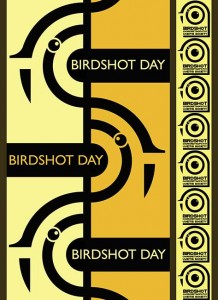The Birdshot Uveitis Society held their first Birdshot Day in September 2010. Around 130 people attended – birdshot patients, family members and health professionals – to increase patient and professional awareness and involvement with the problems of birdshot.
BUS acknowledges the help received from many individuals and organisations in putting together the Birdshot Day, especially Miss Narciss Okhravi, uveitis consultant, Moorfields Eye Hospital, London.
Here is a five-minute video which explains why and how the Birdshot Day was organised. It gives you an introduction to the many activities included in the Day.
Below is a link to the programme of speakers who took part.
https://birdshot.org.uk/wp-content/uploads/Programme-BirdshotDay-.pdf
DVD of the Birdshot Day 2010

We have copies of the Birdshot Day 2010 DVD available. It contains recordings of all the Day’s talks, interviews with people with birdshot, health professionals, charities and low vision specialists.
We have a limited stock. If you would like a copy, please email us info@birdshot.org.uk with your name and address. Rather than charging for the DVD, we suggest you make a small donation to BUS. This will help pay for the postage and packaging costs, with the extra going towards funding a future Birdshot Day. To do this, please click the link below. https://www.justgiving.com/birdshotuveitissociety
Audio clips from Birdshot Day 2010
Mike Brace on vision loss
The inspirational Mike Brace CBE, Chief Executive of VISION 2020 (UK) talks about losing sight in one of his eyes from a firework accident when he was 12, the subsequent development of uveitis in his remaining eye, and how he has dealt with this. He vividly describes life following his sudden loss of vision at such a young age. He explains exactly what challenges he faced, and how he never let his loss of vision hold him back from achieving.
https://audiomack.com/embed/birdshot-recordings/song/mike
Carlos Pavesio talks about birdshot
Carlos Pavesio, consultant ophthalmologist, is interviewed by Mikael Porath-Petersen at the Birdshot Day 2010 about this rare sight-threatening condition.
https://audiomack.com/embed/birdshot-recordings/song/carlos-2
Mrs Birdshot has had birdshot for over 30 years. It took a long while for her to be diagnosed, and over the years she has received a number of different treatments, some more successful than others. Hers is a positive story. She has maintained her vision, she doesn’t regard herself as ill and doesn’t want to be thought of as a patient. She wants to have a partnership approach to her treatment with her doctor.
https://audiomack.com/embed/birdshot-recordings/song/mrs-birdshot
Carole has been treated for a number of years and has maintained reasonable vision.
https://audiomack.com/embed/birdshot-recordings/song/carole
Lesley is a young woman who has been treated for her birdshot for over 10 years. She’s had a tough time finding the right treatment for her birdshot and her arthritis, but her current medication is controlling both and she couldn’t be happier.
https://audiomack.com/embed/birdshot-recordings/song/lesley
Bringing Together Patients and Specialists – poster presentation describing the Birdshot Day 2010
This is the abstract of the poster that trainee ophthalmologist Nik Koutroumanos presented at the London, Kent, Surrey and Sussex Deanery Trainees conference in March 2011. It describes what happened at the Birdshot Day 2010. Nik’s presentation generated quite a lot of interest among the young doctors attending. They will have gone away from their conference with much more awareness of our particular rare condition. There is great value in educating future ophthalmologists who are not yet committed to a subspecialty area of uveitis and who will be carrying the knowledge of birdshot to the corneal, vitreoretinal and paediatric eye clinics in which they will inevitably become involved. Thanks, Nik, for helping to spread the word.
Purpose: Birdshot chorioretinopathy (BCR) is a rare, chronic, poorly understood, bilateral posterior uveitis, which results in loss of visual function. The disease and its treatment have dire effects on quality of life. The aims of the project were five-fold: 1) to reduce the sense of isolation of patients with BCR 2) to raise the profile of the disease 3) to allow a two-way exchange of information between patients and professionals 4) to obtain a better visual outcome and 5) to provide a base for research.
Methods: A Birdshot Day was organised by founders of the Birdshot Uveitis Society along with a team of healthcare professionals, public-engagement and audio-visual specialists. ‘What patients wanted’ was the focus of the team’s efforts. The event allowed for extensive networking and exchange of ideas, talks by specialists and patient representatives and ‘Question & Answer’ sessions which addressed patients’ concerns. Structured anonymised questionnaires and formal interactive evaluation techniques were used to fully evaluate the success and short and long term impact of the Birdshot Day on both patients and professionals.
Results: 50 patients and 26 supporters joined 50 healthcare professionals for the Birdshot Day. Data analysis demonstrated a significant improvement in patient knowledge (P<0.001). Results showed that the priorities of patients and clinicians were not necessarily the same. Whilst drug side-effects were deemed the major problem in terms of patients’ quality of life (55.8%), BCR patients prioritised research into aetiology (47.8%) in preference to research into better medication (31.8%). There was evidence that patients greatly valued meeting fellow sufferers (P<0.001). Results strongly suggested that patients’ sense of isolation was significantly reduced and the number of ‘hits’ on the BUS website in the three weeks following the event more than doubled to 67,000. To date, four of our five aims have been achieved.
Conclusions: We believe that this level of patient engagement should be encouraged. The Birdshot Day proved a success. It has led to better understanding between patients and professionals. Patients have successfully directed and engaged into future research into their condition and future Birdshot Days are planned.
Postscript: after the trainees’ conference, Nik told BUS that he found that many of those attending were greatly interested in the concept of a ‘patient day’ for a rare condition. He also thought that it was most valuable to be able talk to trainee ophthalmologists about the significance of involving patients in research.
Revised February 2024